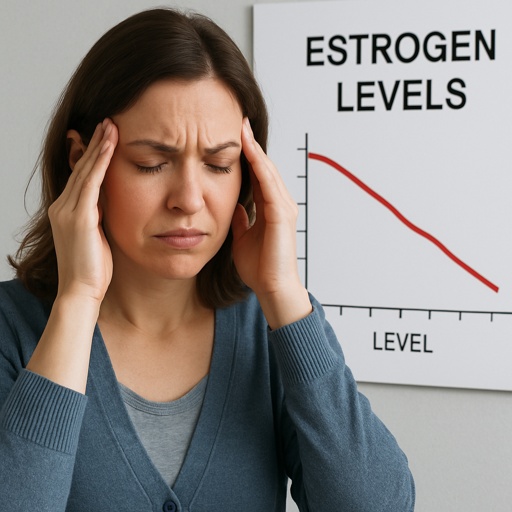Introduction to Migraines in Women
Migraines are more than just a bad headache. They are a complex neurological condition that disproportionately affect women, with females being three times more likely than males to experience them. 1 in 5 women (20%) have migraine, as compared with 1 in 16 men. This disparity is primarily influenced by biological, hormonal, and environmental risk factors that uniquely impact women throughout their lives. Migraine headaches can manifest as severe, throbbing pain, often accompanied by nausea, sensitivity to light or sound, and visual and other neurological disturbances.
The nature of migraines in women is often linked to hormonal fluctuations, particularly those involving estrogen. These changes can occur at various points, including puberty, the menstrual cycle, pregnancy, and menopause, each potentially altering the frequency and intensity of migraine episodes. For many women, migraines are not just occasional headaches but chronic conditions that interfere with daily life, work, and relationships.
Aside from hormonal influences, external triggers such as stress, lack of sleep, specific foods, and environmental stimuli can contribute to migraine attacks. Many women find that identifying these triggers is key to managing their condition. Genetic predisposition may also play a role, with a family history of migraines often indicating a higher likelihood of experiencing them.
Despite the widespread nature of migraines in women, every woman’s experience is unique, influenced by a combination of internal and external factors. This complexity can make treatment options challenging, but it also underscores the importance of individualized care.
Hormonal Factors in Migraine
Hormonal fluctuations, particularly involving estrogen, play a critical role in why women experience migraines more frequently than men. The estrogen withdrawal hypothesis suggests that migraines occur when estradiol levels fall below 45–50 pg/mL following a period of higher levels. This sensitivity to hormonal changes is especially notable in women who already have a history of migraines. As they are particularly sensitive to changes in estradiol levels.
The menstrual cycle is one of the most significant times when hormone levels shift, which is why many women report migraines associated with their menstrual period. These menstrual migraines often coincide with the drop in estrogen that occurs just before menstruation begins. Up to 70% of female migraine sufferers report a menstrual association with their headaches. Such migraines can be particularly severe and may not respond as well to standard treatments.
Other hormonal changes throughout a woman’s life, including pregnancy, postpartum shifts, gynecological surgeries, and the transition to menopause, can also significantly affect migraine patterns. These stages often bring dramatic fluctuations in estrogen levels, which may either worsen or, in some cases, improve migraine symptoms. Understanding this intricate connection between hormones and migraines is vital to tailoring effective treatment strategies that address these changes directly.
Hormonal Treatment Strategies For Migraine
Hormonal treatments can play a pivotal role in managing migraines in women, particularly when hormonal fluctuations are a key trigger. For some, stabilizing estrogen levels through the use of hormonal therapies like oral contraceptives or hormone replacement therapy (HRT) may help reduce the frequency and severity of migraine attacks. Adjustments to contraceptive regimens can be particularly beneficial for women experiencing migraines linked to their menstrual cycle. Using long acting oral combined (estrogen/progesterone) contraceptive pills to help limit placebo day frequency (to avoid migraine triggering estrogen drop frequency) can be a helpful strategy. Changing oral contraceptive regimens to a 9 weeks on, 1 week off schedule was shown to reduce migraine frequency from 17.3% to 9.7%.
Low-dose estrogen treatments, such as estrogen patches or gels, are another option that may help minimize estrogen withdrawal, a common trigger for migraines just before menstruation. These treatments aim to maintain steadier hormone levels, which can be particularly useful for women who experience menstrual migraines.
However, the decision to use hormonal therapies should be made with caution and under the guidance of a healthcare provider. Not all women are candidates for these treatments due to potential side effects or pre-existing conditions. For example, women who have a history of blood clots, stroke, or certain types of cancers may need to avoid estrogen-based therapies. Some women with migraine with aura are cautioned with estrogen use and increased stroke risk.
In some cases, non-estrogen-based hormonal options, like progesterone-only contraceptives, may be recommended. These alternatives can be helpful for women who cannot tolerate estrogen, for whom estrogen exacerbates their symptoms, or whom may be at risk of stroke with migraine aura.
It’s important for women to work closely with their healthcare provider to determine the most appropriate hormonal treatment, considering both the potential benefits and risks. Regular monitoring and adjustments may also be necessary to ensure optimal results and minimize adverse effects.
Non-Hormonal Treatments For Migraine
Non-hormonal treatments for migraines offer a range of options, from over-the-counter medications to advanced preventive prescription therapies.
For mild to moderate migraine headaches, a nonsteroidal anti-inflammatory drug (NSAIDs) like ibuprofen, naproxen, and acetaminophen, are commonly used to alleviate symptoms acutely. These medications work best when taken at the first signs of a migraine. For women experiencing more severe or recurring migraine episodes or not responding to over-the-counter medications, triptans or gepants are often a first-line prescription option.
Triptans target specific serotonin receptors to reduce inflammation, interfere with pain pathways, and constrict blood vessels, addressing some of the underlying mechanisms of migraine pain. The gepants block calcitonin gene-related peptide (CGRP) proteins involved in migraine attacks. Ditans are designed to calm overactive brain pathways by targeting a specific serotonin receptor linked to migraine attacks.
Menstrual migraines are usually of long duration, lasting several days. Use of long acting triptans (Naratriptan, Frovatriptan) can help to eliminate the recurrence of migraine coming back the next day. If that doesn’t help, using a “mini-prophylaxis” strategy around menses is used. This is where half a tablet of one of these triptans is taken twice daily starting 1-2 days before the expected menstrual cycle start. This is continued for several days into the cycle. If a migraine breaks through, a full dose of the triptan can still be used (no more than 2 total pills per day). Nurtec is a gepant medicine that can also be used as mini-prophylaxis before the start of menses by using it once daily or every other day starting 1-2 days before the menstrual cycle starts, and continued through the cycle. If a migraine breaks through, another medicine such as a triptan can also be used since there is no interaction. Ubrelvy is another gepant that can also be used for menstrual migraine since it is a longer acting abortive. Dihydroergotamine (DHE) is also a very good option for menstrual migraines since it is very long acting, up to 72 hours.
It’s important to avoid worsening of migraines from medication overuse headaches (rebound headache) by limiting how many days of triptans and over the counter pain medicines are used each month.
Preventive medications may also be recommended for women with frequent or debilitating migraines. These prescription drugs include beta blockers, antiepileptic drugs, and certain antidepressants, all of which help reduce migraine frequency. Newer migraine specific preventive medications working as CGRP inhibitors (CGRP monoclonal antibodies and gepants) have emerged as a promising preventive option. These medications, administered as injections or oral pills, specifically target pathways involved in migraine development, offering relief for many women who haven’t responded to other treatments. Botox is also commonly used for chronic migraine treatment.
Non-pharmaceutical approaches can complement medical therapies. Regular physical activity has shown potential in reducing the frequency of migraines by improving blood flow and supporting stress management. Techniques like biofeedback and cognitive behavioral therapy (CBT) can help women identify stressors and develop effective coping mechanisms. These strategies are particularly useful for women who find stress to be a major trigger for their migraines.
Additionally, some women benefit from alternative and complementary treatments such as acupuncture and supplements which may help reduce the intensity and frequency of migraine attacks. While research into these methods is ongoing, they are generally considered safe when conducted by trained professionals. Working with a healthcare provider to explore these non-hormonal strategies ensures a well-rounded and effective approach to managing migraine symptoms.
Lifestyle and Environmental Triggers and Adjustments For Migraine
Certain lifestyle choices and environmental factors can significantly impact the likelihood of experiencing migraine headaches. Stress and anxiety are well-known triggers, as they can cause physical and hormonal changes in the body that lead to migraine episodes. For women, managing stress through relaxation techniques, mindfulness, meditation or deep breathing exercises can be particularly helpful in reducing the frequency of attacks.
Sleep plays an equally important role. Irregular sleep patterns, such as staying up too late or not getting enough rest, can disrupt the body’s natural rhythms, potentially triggering migraines. Maintaining consistent sleep habits and ensuring quality rest can make a noticeable difference for many women. Establishing a structured sleep routine is particularly important, as both insufficient sleep and oversleeping can provoke migraines. Going to bed and waking up at the same time each day, even on weekends, helps maintain the body’s natural cycles. Incorporating a calming pre-sleep routine, such as limiting screen time or practicing relaxation exercises, may also improve sleep quality.
Dietary habits and avoiding dietary triggers are another area where intentional changes can make a difference. Certain foods and beverages are common migraine triggers, with caffeine, alcohol, aged cheeses, foods containing additives like monosodium glutamate (MSG), artificial sweeteners ,nitrites and nitrates being frequent culprits.
Meal timing and keeping a food journal to track what you eat and how it affects your symptoms can help identify specific triggers. Skipping meals, dehydration, or sudden changes in blood sugar levels can also provoke migraines, so eating balanced meals and staying hydrated is essential. Eating smaller, well-balanced meals at regular intervals throughout the day can help maintain stable blood sugar levels, reducing the risk of migraines linked to hunger or sudden changes in glucose levels.
Environmental factors and stimuli are another important consideration. Exposure to bright lights, flashing lights, strong odors, smoke, loud noises, weather changes, and workplace environment triggers can exacerbate symptoms or initiate a migraine attack. For women who are sensitive to such triggers, using tools like noise-canceling headphones or migraine glasses which block blue, red, and amber light wavelengths can create a more migraine-friendly environment.
Regular physical activity can also provide relief, as exercise supports overall health and helps manage stress, a frequent trigger for migraine headaches. Activities such as walking, swimming, or yoga can be particularly beneficial, as they promote circulation and relaxation without placing undue strain on the body. It’s important to start gradually, as overly strenuous workouts might worsen symptoms in some individuals.
By identifying these specific factors and making adjustments to daily routines, women can reduce their exposure to triggers and better manage their migraines.
Genetic Predispositions For Migraine
Genetic predisposition is a significant factor in the development of migraines, particularly among women. Research has shown that migraines often run in families, suggesting a hereditary component that increases susceptibility. This means that if close relatives, such as parents or siblings, have a history of migraines, there is a higher likelihood of experiencing them as well. While the exact genetic mechanisms remain under investigation, scientists have identified certain genes associated with migraine susceptibility, particularly those that influence how the brain processes pain and regulates blood vessels.
For women, the genetic risk of migraines may intersect with hormonal factors, compounding the likelihood of experiencing migraine headaches during specific life stages. Inherited traits may make the brain more sensitive to certain triggers, whether hormonal, environmental, or lifestyle-related. Understanding the role of genetics in migraine development not only highlights the importance of family medical history but also underscores the need for individualized approaches to prevention and treatment.
Conclusion
Migraines in women present a unique challenge due to their connection with hormonal fluctuations and other individual factors. Understanding these influences is key to finding effective management strategies. For women, the hormonal changes linked to life stages such as menstruation, pregnancy, and menopause often play a central role in triggering migraines. However, external factors like stress, sleep disruptions, dietary habits, and environmental stimuli can also contribute, highlighting the importance of a holistic approach to care.
Treatment should be tailored to the individual, as no single solution works for everyone. Women may find relief through a combination of hormonal therapies, medications, and non-pharmaceutical methods, such as relaxation techniques or lifestyle changes. Preventive strategies like maintaining consistent routines, observing for possible triggers and avoiding known triggers can also reduce the frequency and severity of migraine episodes.
Collaboration with a healthcare provider is critical in developing an effective treatment plan, especially for identifying the best therapeutic options based on specific triggers and medical history. Any headache should be discussed with your motor to ensure there are no other medical conditions causing the frequent migraines. Women should feel empowered to advocate for their needs and explore a range of options to manage their migraines effectively.
Though migraines can be disruptive, understanding their underlying causes allows for more targeted and effective treatments. With the right combination of medical guidance and personal adjustments, many women can significantly improve their quality of life and minimize the impact from migraines.
IF YOU HAVE HEADACHE, MIGRAINE, OR FACIAL PAIN AND ARE LOOKING FOR ANSWERS ON ANYTHING RELATED TO IT, A HEADACHE SPECIALIST IS HERE TO HELP, FOR FREE!
FIRST, LET’S DECIDE WHERE TO START:
IF YOU HAVE AN EXISTING HEADACHE, MIGRAINE, OR FACIAL PAIN DIAGNOSIS AND ARE LOOKING FOR THE LATEST INFORMATION, HOT TOPICS, AND TREATMENT TIPS, VISIT OUR FREE BLOG OF HOT TOPICS AND HEADACHE TIPS HERE. THIS IS WHERE I WRITE AND CONDENSE A BROAD VARIETY OF COMMON AND COMPLEX MIGRAINE AND HEADACHE RELATED TOPICS INTO THE IMPORTANT FACTS AND HIGHLIGHTS YOU NEED TO KNOW, ALONG WITH PROVIDING FIRST HAND CLINICAL EXPERIENCE FROM THE PERSPECTIVE OF A HEADACHE SPECIALIST.
IF YOU DON’T HAVE AN EXISTING HEADACHE, MIGRAINE, OR FACIAL PAIN DIAGNOSIS AND ARE LOOKING FOR POSSIBLE TYPES OF HEADACHES OR FACIAL PAINS BASED ON YOUR SYMPTOMS, USE THE FREE HEADACHE AND FACIAL PAIN SYMPTOM CHECKER TOOL DEVELOPED BY A HEADACHE SPECIALIST NEUROLOGIST HERE!
IF YOU HAVE AN EXISTING HEADACHE, MIGRAINE, OR FACIAL PAIN DIAGNOSIS AND ARE LOOKING FOR FURTHER EDUCATION AND SELF-RESEARCH ON YOUR DIAGNOSIS, VISIT OUR FREE EDUCATION CENTER HERE.




